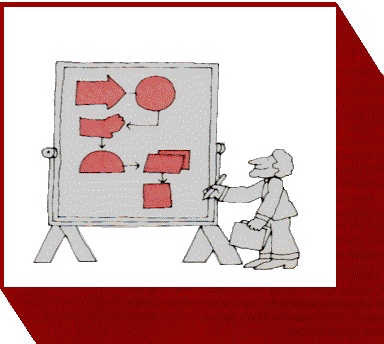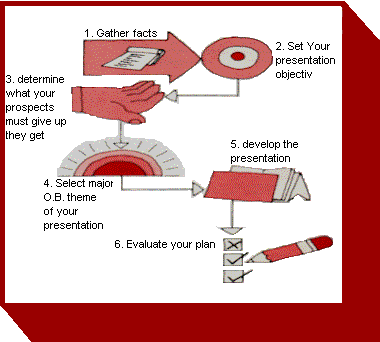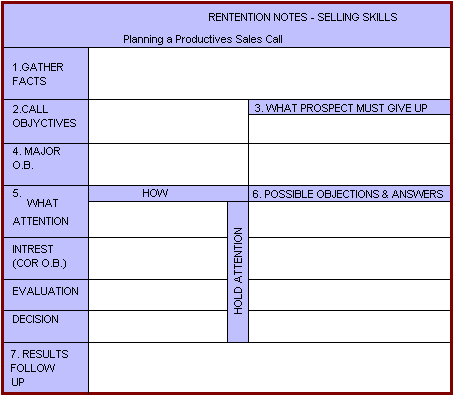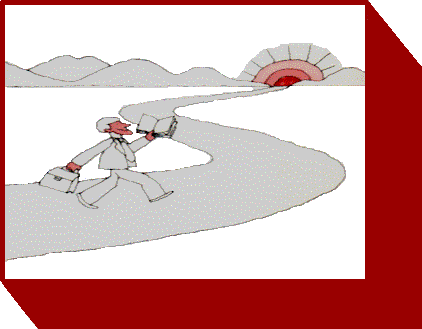|
Presentation
Planning As was pointed out earlier, except for the o.b., the g.q., and the offer, use of one motivation idea or another is determined by the prospect's response and behavior during the presentation. Few sales representatives are able to weigh that response as it occurs and, simultaneously, select and use appropriate motivation ideas. Professionals don't try. They know there's a sounder, more effective way to lead the prospect through the buying motion-by planning the sales presentation. Planning your sales presentation has many benefits. It enables you to: ∑ Predetermine what you want the prospect to accept (the plan that best fills the prospect's needs);∑ Lay out in advance the key points that must be made to get acceptance;∑ Anticipate objections, neutralize them before they occur, or have answers for them if they do crop up;∑ Deliver a more organized presentation;∑ Measure progress during the presentation; Be more effective.Despite these advantages, few sales representatives in the life insurance industry plan
their presentations. Not surprisingly, those that do are the most successful.
If effectiveness and success are so closely related to presentation planning, why then do so few sales representatives practice itl There are several answers. ∑ Some are not aware of the benefits.
∑ Others simply don't know how.Point one was dealt with earlier. Point two is valid. Presentation planning does require time. (More often than not at least one Fact Finding call must precede any planned call on which the sales representative's objective is to close a predetermined amount of business.) But, if the added time required to make a Fact Finding call subsequently results in a quality call, i.e., one that gets the business, the additional time is certainly worth the effort. Furthermore, we seriously doubt that any sates representative or sales manager in the life insurance industry will feel that such a multiple-call closing effort is in conflict with the industry's quantitatively-oriented success formula. As for the third major reason often given for not planning sales
presentations-"Don't know how"-this no longer need be an excuse. A sound and
simple approach to presentation planning, one that ties together all the motivation ideas
in this module, is explained in the six steps below.
Step one: Gather facts Learn air you can about your prospects, their current situations, their aspirations, their problems and needs. In doing so, recall what was sad earlier in this module. If buyers have objectives, they will have problems in attempting to achieve them and a need to solve those problems. However, prospects often cannot clearly state their objectives. Therefore, their conceptions of their problems and needs are frequently fuzzy and shortsighted. Small wonder so many prospects don't respond to o.b.'s offered by those sales representatives who do use them! They can't relate these o.b.'s to clear and immediate needs! In gathering facts, therefore, try to identify meaningful objectives for your prospects and to crystallize problems that prevent them from realizing those objectives. If these objectives and problems are thought out, then laid out in a logical, orderly manner, your prospects' needs will be more apparent to them. And you will have a clearer conception of what you are going to sell and what you want prospects to accept. You might note, incidentally, that of all the sales tools available to sales representatives to help convey ideas to their prospects, none is better designed to help them to the above-mentioned job than the Work Sheets in The Life Insurance Needs Analysis sales procedure. Step two: Set your presentation objective If you have done a thorough lob of gathering facts, step two will be virtually automatic, especially if the The Life Insurance Needs Analysis Work Sheets have been used. This is supported by an old management saying about the decision-making and planning process, "When all the facts are available, decision-making is reduced and planning becomes a more mechanical process." It pay's, therefore, to take the time to gather and evaluate as many facts as possible about your prospects and their situations. There is no way you can develop sound presentation objectives without doing this. Step three: Determine what the prospects must give up This is the one fact sales representatives invariably overlook But their prospects don't. It's the one thing they consider most in the evaluation phase of the buying motion. This generally can he expressed in terms of time! money, or effort. But it might also involve a relationship with another individual or firm. And it might involve an attitude toward you, your firm, or even the concept of insurance. identifying what prospects must give up if you are to accomplish your objective does two things ∑ It helps you determine whether your offer is "worth it" in your prospects' eyes-whether they are likely to think they will gain more than they have to give up.∑ It helps you identity objections you may have to overcome in your presentations.Step four: Select the major o.b. theme of your presentation Our insurance company's issues many types of policies. Each contains a variety of clauses, options and terms. Since each policy, each clause or option can provide your prospect with certain benefits, your biggest problem maybe selecting the one benefit most meaningful to your prospect, i-e., the major o.b. But if you've done your homework, if you've learned about the prospect's current
situation, aspirations! and problems; if you really can identify the needs, your lob will
be a lot easier. You'll know the one owner benefit that will best fill those needs. And how will you express it? Remember, the o.b. you select should be one that your prospect will see as a gain once you've brought the needs into perspective. It also should be one that out weighs that which must be given up. Your entire presentation will be built around this ob. Your needs analysis (Work Sheet will set the stage for it and your g.q. will ensure that the prospect will get the o.b. in the particular solution you are going to offer. This is why the major o.b. serves as a theme for your presentation. Step five. Develop the presentation Now you are ready to lay out your sales talk, i.e., to select the motivation ideas you'll use, the sequence in which you'll use them, and the way you'll actually express each idea. Start with the attention phase of the buying motion. Knowing the prospect as you do, decide what will put him at ease, make him want to listen. Select the emotion motivation idea you'll use as an "ice-breaker"-will you use common interest or appeal to pride or both? How would you make a favorable impression? Be specific. Selecting a motivation idea by name is not enough. Decide how you will express it. Better to work this out flow than when you're walking into the prospect's home or office. Doing so will put you at ease and this, in turn, will help put your prospect at ease. It also will tree your mind to concentrate on your prospect and what might occur early in the interview. Also select the specific question (another emotion motivation idea) you will use to hold your prospect's attention while making your transition into the interest phase of the buying motion. Remember that your prospect's only real concern here is, "What's in it for me?" Your major o.b. will answer this question satisfactorily if it lines up with the needs as the prospect sees them. Be certain, therefore, that your presentation enables you to fully discuss your prospect's needs before you express your major o.b. In your Fact Finding interview, you should be prepared to use different types of questions (open, closed, mirror, echo) to ensure that all the relevant information is obtained without the interview seeming to be an interrogation. Your major ob. on such a call might relate to pulling this information together in an organized manner Certainly your prospect would recognize the need for this. Thus, in all likelihood, he will "buy" the only thing you have to sell at this point-a presentation interview. In your presentation interview you undoubtedly will use your Work Sheets to crystallize the prospect's need before you roll out your major ob. Think through the additional questions you will use to hold attention and check for understanding and agreement once you've expressed the major o.b. If your prospect has no objections you can proceed to the evaluation phase whore you wil identify the source of the benefit you've promised (the g.q.) and express your offer. Have in mind the way you will describe the plan you are going to offer as well as the premium and terms necessary to acquire it. A rebuttal, on the other hand, wilI require you to use one or another of the additional
reason motivation ideas-the comparison statement, the prestige statement, the
explanation-demonstration, etc. What kind of rebuttal can you anticipate? Which motivation
idea win you use? How will you express it? And what about oblections2 Which are likely to
occur? What o.b.'s, other than your major o.b., do you have to overcome them? Having answers for each of these questions ahead of time is the difference between moving ahead to the decision phase and getting bogged down, losing sales progress and possibly, the sale. Finally, identify the closing technique you'll use and work out in your mind the way you'll express it. Sounds like work? It is. Rut predetermining those things will put the odds in your favor. And that's the most important advantage you can have in any selling situation. Beyond this! once you've developed the habit of presentation planning, it becomes easier, almost intuitive, because it is -a part of you. It is your way of thinking and the cornerstone of all your service to your prospects. We should add that without such planning, your chances of closing are fifty - fifty at best, and it will be an uphill battle all the way. The prospect will lead the interview, and you will never be quite certain where you stand. in addition, if you do close the sale, you'll never know why. Thus, the likelihood of repeating your successful performance will be slim indeed. Your career is too important to develop on a hit-or-miss basis. Put the odds in your favor. Plan. Step six: Evaluate the plan The goal here is to make certain your plan will work-that you will be able to reach the presentation objective as set in Step two. So think before acting. Is the objective realistic? Can it be reached? Are the o.b.'s you plan to use strong enough to convince the prospect that there is more to be gained than has to be given up in time, money or effort? These steps are the backbone of your presentation. If they're weak, your presentation will be too. You are not making calls for the sake of making calls. Go hack, therefore, and re-plan. On the other hand if all makes sense proceed Odds are that you're on your way to a
successful sale.
A Concluding Thought Selling skills don't just happen! To learn them will is the first step toward improvement. To use them effectively is the second. The latter takes discipline, perseverance and practice If you wish to excel in selling and gain the recognition of your peers as a
professional, you will have to follow these selling concepts. At this point you can
recognize that if professional selling were an innate, instinctive, normal form of human
behavior, many more people would be building their fortunes and reputations on it. If you
have the will to learn and practice these concepts, the future is yours!
Summary-Presentation planning I. The most effective way to lead a prospect through the buying motion is by planning the sales presentation. A. Planning your sales presentation has many benefits It enables you to: 1. Predetermine what you want the prospect to accept. 2 Lay out in advance the key points that must be made to gain acceptance. 3. Anticipate objections, neutralize them before they occur, or have answers ready for them if they do crop up. 4. Deliver a more organized presentation. 5. Measure progress during the presentation. B. Despite its benefits, few sales representatives practice presentation planning. 1. Some are not aware of the benefits 2. Some feel at takes too much time. 3. Others simply don't know how. II. Here is a sound and simple approach to presentation planning that ties together all of the motivation ideas in this module: A. Gather facts 1. Learn all you can about your prospects, their current situations, their aspirations, their problems and needs. 2. Try to identify meaningful objectives for your prospects and to crystallize problems that prevent them from realizing those objectives. B. Set your presentation objective 1. If you have done a thorough job of gathering facts, this step should be virtually automatic, especially if the The Life Insurance Needs Analysis Work Sheets have been used. C. Determine what your prospects must give up for what they get. 1. This is what prospects consider most in the evaluation phase of the buying motion. 2. It can generally be expressed in terms of time, money or effort. D. Select the major ob. theme of your presentation I. if you've done your homework-learned about the prospect's current situation, aspirations and problems you will be able to select the one owner benefit that best fills those needs. Your entire presentation will be built around this ob. E. Develop the presentation 1. Start with the attention phase. Select the emotion motivation idea you'll use as an icebreaker. 2. Select the specific question you will use to hold your prospect's attention while making your transition into the interest phase of the buying motion. 8. Remember that your prospect's only real concern is "What can you do for me?" 4. Express your major o.b. after determining your prospect's needs. 5. If your prospect has no objections, you can proceed to the evaluation phase where
you will identify the source of the benefit you've promised (the g.q.) and express your offer. 7. Predetermining these factors will put the odds in your favor. Without presentation planning, your chances of closing the sale are less than fifty - fifty. F. Evaluate your plan I The goal here is to make certain that your plan will work. 2. Is the objective realistic? Can it be reached? 3. Are the o.b.'s you plan to use strong enough to convince the prospect that there is more to gain than has to be given up in money, time or effort? Ill. These steps are the background of your presentation. IT they're weak, your presentation will be too, Summary: A concluding thought-selling skills don't just happen'. I. The buying motion and motivation ideas discussed give us standards for professional selling. II. To learn them well is the first step. To use them effectively is the second. Ill. If you wish tc excel in selling, you will have to follow these professional
selling concepts. What can I do to improve? TOP
|




